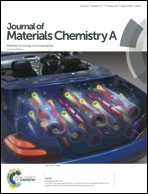Stacking up layers of polyaniline/carbon nanotube networks inside papers as highly flexible electrodes with large areal capacitance and superior rate capability†
Abstract
Developing high-performance flexible film-like electrodes is still a primary task for the practical applications of wearable/portable planar supercapacitors. In this work, a facile and effective approach, i.e., stacking up layers of polyaniline (PANI)/carbon nanotube (CNT) composite networks inside air-laid papers, is proposed to fabricate highly flexible paper electrodes with large areal capacitance and superior rate capability. The layer-by-layer deposition of PANI/CNT networks endows the fabricated paper electrodes with high loading and uniform distribution of PANI; meanwhile, the good electrical conductivity and porous structure of these introduced PANI/CNT networks guarantee sufficient paths for electron movement and ion transportation in the electrodes. Consequently, when 4 layers of PANI/CNT networks (with optimal PANI content) are stacked inside papers, the areal capacitance of the prepared electrode is as high as 1506 mF cm−2 at a charge/discharge current of 10 mA cm−2 and 1298 mF cm−2 at 100 mA cm−2; the electrode also exhibits high flexibility and good cycling stability (with 82% capacitance retention after 11 500 charge/discharge cycles). These merits make our PANI/CNT/papers promising candidates for flexible planar supercapacitor electrodes. Besides, this work is believed to provide a new thought for producing high-loading and high-energy wearable/portable energy storage devices.



 Please wait while we load your content...
Please wait while we load your content...